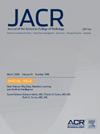A Systematic Review and Meta-Analysis of Racial Disparities in Hemodialysis Vascular Access Utilization and Outcomes in the United States
IF 5.1
3区 医学
Q1 RADIOLOGY, NUCLEAR MEDICINE & MEDICAL IMAGING
引用次数: 0
Abstract
Objective
This systematic review compares the utilization and outcome of hemodialysis vascular access among racial groups in the United States, highlighting disparities and their implications.
Methods
The original search using Medline, Embase, Cochrane, and PubMed yielded 349 studies, of which 32 met inclusion criteria. Data on utilization rate, patency, maturation, complications, and survival rate were collected.
Results
In pooled analyses, Black patients had significantly lower odds of receiving fistula (odds ratio [OR] 0.67, 95% confidence interval [CI] 0.58-0.77) but twice the odds of receiving grafts (OR 2.01, 95% CI 1.60-2.53) for access than White patients. No statistically significant difference in the odds of dialysis catheter existed between the two groups (OR 0.89, 95% CI 0.66-1.19). According to 7 of 32 studies, Black patients also experienced a higher risk of fistula failure, lower rate of fistula maturation, higher risk of graft and fistula patency loss, and higher complications compared with White patients. Pooled analyses showed no statistically significant difference in the odds of fistula use between White and Hispanic patients (OR 0.93, 95% CI 0.76-1.15). According to 5 of 32 studies, Hispanic patients experienced slightly higher rate of grafts, slightly higher probability of fistula maturation, and slightly better patency rates for both grafts and fistulas than White patients. Mortality rates after vascular access procedures were higher in White than all non-White patients combined. Data regarding vascular access in other racial and ethnic minorities were limited.
Discussions
Overall, Black patients disproportionately received inferior hemodialysis vascular access choices and experienced worse outcomes. These findings highlight the need for interventions to address hemodialysis care disparities in the United States.
美国血液透析血管通路利用和结果的种族差异:系统回顾和荟萃分析。
目的:本系统综述比较了美国不同种族血液透析血管通路的使用和结果,突出了差异及其意义。方法:使用Medline、Embase、Cochrane和PubMed进行原始检索,获得349项研究,其中32项符合纳入标准。收集了使用率、通畅度、成熟度、并发症和生存率的数据。结果:在汇总分析中,黑人患者接受瘘管的几率明显低于白人患者(OR 0.67, 95% CI 0.58-0.77),但接受移植物的几率是白人患者的两倍(OR 2.01, 95% CI 1.60-2.53)。两组患者使用透析导管的几率差异无统计学意义(OR 0.89, 95% CI 0.66-1.19)。根据7/32的研究,与白人患者相比,黑人患者的瘘管衰竭风险更高,瘘管成熟率更低,移植物和瘘管通畅丧失的风险更高,并发症也更高。合并分析显示,白人和西班牙裔患者使用瘘管的几率无统计学差异(OR 0.93, 95% CI 0.76-1.15)。根据5/32的研究,西班牙裔患者的移植物率略高,瘘成熟的概率略高,移植物和瘘管的通畅率略好于白人患者。白人患者血管通路手术后的死亡率高于所有非白人患者的总和。其他种族和少数民族的血管通路数据有限。讨论:总体而言,黑人患者不成比例地接受了较差的血液透析血管通路选择,并经历了较差的结果。这些发现强调了干预措施的必要性,以解决血液透析护理差距在美国。
本文章由计算机程序翻译,如有差异,请以英文原文为准。
求助全文
约1分钟内获得全文
求助全文
来源期刊

Journal of the American College of Radiology
RADIOLOGY, NUCLEAR MEDICINE & MEDICAL IMAGING-
CiteScore
6.30
自引率
8.90%
发文量
312
审稿时长
34 days
期刊介绍:
The official journal of the American College of Radiology, JACR informs its readers of timely, pertinent, and important topics affecting the practice of diagnostic radiologists, interventional radiologists, medical physicists, and radiation oncologists. In so doing, JACR improves their practices and helps optimize their role in the health care system. By providing a forum for informative, well-written articles on health policy, clinical practice, practice management, data science, and education, JACR engages readers in a dialogue that ultimately benefits patient care.
 求助内容:
求助内容: 应助结果提醒方式:
应助结果提醒方式:


